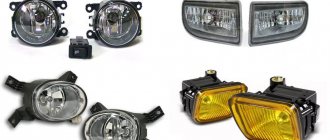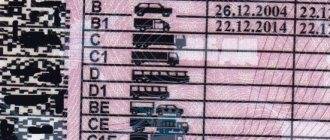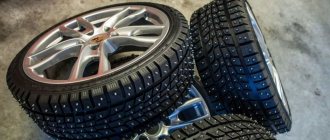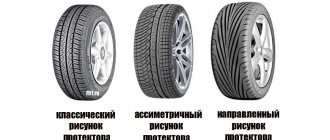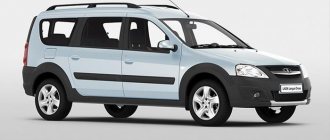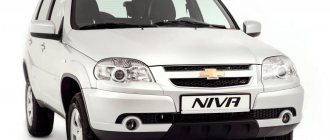1. Tire brand 2. Designation of maximum load 3. Wear resistance index 4. Grip index 5. Temperature index 6. Maximum pressure 7. Manufacturer 8. Designation 9. M+S 10. Tire size 11. Load capacity 12. Speed category 13 .Design details
1. Tire brand
(name of the tire model), example: Nord Frost 3. Trademark - determines, first of all, the specific tread pattern, and it also reflects various design and technological features that distinguish this tire from others. Each company uses its own code system, so the same letters and numbers in model indices from different manufacturers can mean completely different tires. If you decide to find out exactly what a particular brand means, use the manufacturer’s catalogs.
2. MAX LOAD
— maximum tire load (in accordance with the requirements of the US Department of Transportation). Some companies decipher it - write in small print MAX LOAD (maximum load) and then indicate the load in kilograms and British pounds (example: MAX LOAD 515kg (1135lbs), 1lbs = 0.4536kg).
It is incorrect to calculate the maximum weight of a car for which tires with a given load are suitable by multiplying MAX LOAD by 4 (i.e. by the number of wheels of the car). The mass obtained in this way turns out to be greatly overestimated. Tires should not operate under maximum weight load. In addition, your car will not only sit on a level surface, but when driving or on uneven surfaces, there may be uneven load on the wheels. Therefore, you need to subtract 20% of its value from the maximum weight - if you have a passenger car, or 30% - if you have an SUV.
3. TREAD WEAR INDEX (TWI)
— wear resistance index.
4. TRACTION INDEX
— index of adhesion qualities.
5. TEMPERATURE INDEX
— temperature index.
These marks are required by US Consumer Information (Quality Level) regulations.
6. MAX PRESSURE
— maximum permissible air pressure in the tire. Indicated in kilopascals and pounds per square inch (example 3.0 kps (44psi), 1psi = 0.0069 MPa for a tire in a “cold” state).
7. Manufacturer
— the name of the tire developer and manufacturer.
8. Symbols for compliance with the requirements of regulatory documents relating to tires:
E17 - compliance with European standards; DOT - compliance with US standards.
9. M+S (Mud+Snow = Mud+Snow)
— indicate that the tire is designed for use in winter conditions or can be used in the presence of mud and snow.
The following designations may also be used: WINTER (winter) - winter tires, AQUA- - rain tires, AS (All Seasons = All Seasons) or AW (Any Weather = Any Weather) - all-season tires suitable for use on hard roads at any time years on any surface, including wet and slippery ones. By the way, recently, many companies, instead of these inscriptions, draw relief pictograms on the sidewalls of tires - sun, snowflake, rain - illustrating all seasons.
10. Tire size designation
When choosing new tires, we are guided, first of all, by their size, or, more correctly, standard size. It is marked on the sidewall of the tire with large symbols, the combination of which looks like this:
195 — tire profile width, mm. Tire section width is the linear distance, expressed in millimeters, between the outer sides of the sidewalls of an inflated tire, excluding elevations due to markings, trim or protective belts or rims;
65 - profile height, indicated as a percentage of the width. In our case, the height is 65% of the width (195 mm), i.e., 126.75 mm. This ratio (H/B, where H is height, B is width) is usually called the tire series. The series is an extremely important parameter; the driving performance of the tires largely depends on it. Some companies (mostly American) put the letter P (Passenger) in front of the size designation, thereby emphasizing that this tire is intended for passenger cars (for example P195/60R14), LT (Light Truck) is a tire for a light truck. Some sizes do not have a series number, for example, 185 R14 C 102 Q. Such tires are called full-profile tires, and the height to width ratio in this case is 80% or 82%. The profile height is half the difference between the overall diameter and the nominal rim diameter. As tire designs have evolved, their shape has changed from almost circular to wider types with a flatter surface. In this case, the ratio of the profile height to its width varied from 100% to 70%, 60%, 50% and to even smaller values.
R15 - the so-called tire radius - is the diameter of the rim on which a tire of this size must be installed. The letter R indicates the radial type of tire.
84 - index or load factor. This is a conditional indicator indicating the permissible load on the tire in kg. The explanation of the most commonly used coefficients is given in the table of load indices. Often, the load is deciphered on the tire itself: the Max Load inscription is followed by two numbers, the first in kg, the second in pounds. Tire load indices.
T - speed index. This indicator indicates the maximum permissible speed at which the manufacturer guarantees that the intended performance characteristics of the tire will be maintained. Tire speed indexes.
In some standard sizes there are additional letter designations: 185 R14 C 102 Q, the index C denotes the so-called “reinforced” tires with a high load factor.
11. Load capacity index (load factor)
- indicates the maximum weight load that the tire can withstand. The two-digit number stamped on the tire is not mathematically tied in any way to specific kilograms - it is simply a conditional index. Tire load indices.
12. Speed category
— the speed symbol shows the maximum calculated speed of the tire. Tire speed indexes.
The speed category assigned to a tire based on the results of special bench tests implies the maximum speed that the tire can withstand. That is, that speed, at the slightest excess of which no one can guarantee that the tire will not begin to fall apart. And for operation, a “gentle” mode is set - the car must drive at a speed 10–15% lower than the one that the tires “allow”.
13. Tire design information
required by the US Department of Transportation. Design features are recorded on the sides with appropriate inscriptions about the number of layers of the breaker and frame, as well as the cord material. For example, the inscription TREAD PLIES: 2 POLYESTER CORD+2 STEEL CORD+1 NYLON CORD means that the tire breaker consists of 2 layers of polyester + 2 layers of steel cord + 1 layer of nylon cord, the inscription SIDEWALL means how many layers the frame (in particular, the sidewall) consists of. , there may also be RAYON - viscose cord.
Where to begin
The vehicle's owner's manual usually contains some recommendations for the correct selection of tires. This takes into account the type of wheels (steel or alloy), season of use (summer, winter), as well as the standard factory size. Naturally, not every driver adheres to such recommendations, which is why the car may be equipped with tires that, in terms of their parameters, do not meet the requirements of the manufacturer.
So it’s better to start by studying the standard requirements for tires of a certain brand of car. If you are satisfied with the type and size of the tires that are installed on the car, you simply need to rewrite all the existing designations.
Marking by season and quality of road surface
Special attention should be paid to the labeling, which indicates compliance with seasonality and coverage. The most common is indicated by the letters M+S. The first of them says that the tire is suitable for off-road driving (literally translated as “dirt”). The letter S means the word “snow”, that is, such a car ramp behaves well when driving on a snowy road surface. In European countries, such a tire is also called “all-season”. However, in the Russian climate they often do not correspond to the conditions of the road surface, and in winter conditions they do not guarantee safe movement.
Among other designations that relate to seasonality, you can find:
- AGT - all-season tire;
- AW, suitable for any weather (Any Weather);
- AS (Any Season), the same properties as in the paragraph above;
- Frost, typically winter tires;
- M/T for very polluted roads;
- A/T is suitable for any type of terrain.
Basic tire parameters: designations, markings
All inscriptions on tires are applied to the sidewalls on both sides. The main symbols on tires provide information about:
- manufacturer;
- standard size;
- speed index;
- load index;
- seasonality of use;
- date of manufacture.
In addition to these, there may be additional symbols on tires informing about:
- tire designs;
- tire type;
- the material from which the sidewall is made;
- maximum permissible pressure;
- direction of rotation;
- heat resistance;
- quality standard, etc.
Manufacturer information
Tire markings containing the manufacturer's name are printed on the sidewalls in large print. It is simply impossible not to notice it.
The manufacturer is the first thing you should decide on. Such popular brands as, for example, Nokian, Michelin, Dunlop, Yokohama, Pirelli, Continental, Bridgestone, do not need any introduction. The tires of these companies are known throughout the world due to their quality and reliability. But there are other manufacturers whose names few people know. In this case, you will need expert advice or a search for objective reviews.
Tire size
This criterion is fundamental in choosing tires. It includes four parameters:
- width;
- profile height;
- type of construction;
- landing (internal) diameter.
The tire size designation looks something like this: 185/65R15, where 185 is the width of the working surface of the tire (in mm), 65 is the percentage of profile height from the width (185:100 x 65% = 120.25 mm), R is the type of construction (radial), 15 – internal diameter (in inches).
Some car enthusiasts often confuse the “R” marking with the radius of the tire. In fact, this is not a designation of tire size, but a type of construction depending on the location of the cord threads. They can be placed either radially (R) or diagonally (D). Bias-ply tires are much less common today, since radial tires, being more practical, have practically supplanted them.
What is an all-season tire
First you need to understand what all-season tires are. What is the difference between winter, summer and all-purpose tires, and which tires are better? The main difference is the chemical composition of the rubber mixture and the tread pattern. All-season tires have a lower tread than winter tires, but they differ in the width of the groove and a larger number of sipes. All-season tires have absorbed all the properties responsible for satisfactory operation both in winter and summer.
The key word here is “satisfactory,” not ideal. In many ways, the operation of a tire depends on climatic conditions and the driving style of the motorist. If, for example, a motorist lives in a region where a huge amount of snow falls in winter, then it will still be safer to drive on Scandinavian-type winter tires. Now it’s worth talking about the pros and cons of all-season tires.
Speed index
This value indicates the maximum permissible speed of the car at which the tires are guaranteed to cope with their tasks. Despite the fact that manufacturers almost always overestimate this parameter, it is strongly not recommended to accelerate your car to this speed. It should also be taken into account here that foreign companies producing tires have no idea about the condition of our roads, so in no case should you try to check the indicated speed indices. On tires, the maximum acceleration designation is marked with one letter of the Latin alphabet, indicating the permissible speed. We most often have rubber marked with the following letters:
- “L” – 120 km/h;
- “M” – 130 km/h;
- “N” – 140 km/h;
- “P” – 150 kph;
- “Q” – 160 km/h;
- “R” – 170 km/h;
- “S” – 180 km/h;
- “T” – 190 km/h;
- “H” – 210 km/h;
- “V” – 240 km/h;
- “W” – 270 km/h;
- “Y” – 300 km/h.
For sports cars and cars participating in various competitions, a special tire designation is provided. The “ZR” speed index, for example, indicates that the rubber can be used in critical speed conditions, i.e. from 240 km/h.
Weight load index
This index indicates the maximum permissible load on one wheel in kilograms. However, you won’t be able to find the right tires by dividing the vehicle’s weight by 4. Here it is necessary to keep in mind that the weight of the car is distributed unevenly between the axles, so the resulting index will be significantly overestimated. First, you need to subtract 20% of its value from the mass of the car (for SUVs - 30%), and only then divide by 4.
Load index designations on tires contain two or three numbers corresponding to a specific weight. To determine this criterion for different types of cars, there are special tables, but we will consider the main approximate indicators for passenger cars:
- 70 – 335 kg;
- 75 – 387 kg;
- 80 – 450 kg;
- 85 – 515 kg;
- 90 – 600 kg;
- 95 – 690 kg;
- 100 – 800 kg;
- 105 – 925 kg;
- 110 – 1030 kg.
It is also worth noting that the higher the load index, the thicker and rougher the tire carcass, which significantly reduces its shock-absorbing qualities.
Winter and summer tires
According to seasonal criteria, all tires are divided into three types:
- summer;
- winter;
- all-season.
Summer tires usually do not have any special markings. It can be visually distinguished from other types by longitudinal grooves designed to drain water. In addition, they are devoid of micropatterns. Summer tires are quite hard, which provides optimal wear resistance and maximum traction at above-zero temperatures.
The designation of winter tires may contain either the word “Winter” or a pictogram in the form of a snowflake. They are significantly softer than summer ones, and have a pronounced high tread with a micropattern. The designation of winter tires with a snowflake guarantees their safe use in severe frost conditions.
Very often, car enthusiasts, seeing markings in the form of the letters “MS” or “M+S” on tires, mistakenly mistake them for winter ones. But this is not a designation for winter tires. This is a marking indicating the possibility of using rubber in special conditions.
The "MS" designation on the tires is "Mud and Snow", which translates from English as "mud and snow". It can be applied to any tires, regardless of seasonality. In other words, the “MS” designation on tires is a sign indicating that this tire is intended for off-road driving or on asphalt covered with wet mud or slushy snow. Such tires are also called lug tires, and they are mostly used either for rally cars or for SUVs.
Classification of car tires
To achieve good vehicle handling, road stability, and cross-country ability, it is necessary that the tires comply with the vehicle and its operating conditions.
There are different types of classification of car tires:
By purpose (seasonality):
- summer, or road - designed for driving at above-zero temperatures on the highway; The products are not suitable for use in winter or for driving on dirt roads;
- winter - used for winter, for movement at sub-zero air temperatures, on roads covered with snow and covered with ice;
- all-season - considered an intermediate option between summer and winter, but inferior to both in organizing high-quality adhesion of rubber to the road surface under the conditions of a certain season;
- universal - suitable for use on highways and dirt roads;
- all-terrain - used for driving on soft soils or off-road.
According to the tread pattern:
- directed and undirected;
- asymmetrical and symmetrical.
By profile size , which is determined by the ratio of tire width to height (measured as a percentage):
- ultra-low profile - up to 50%;
- low profile - from 50 to 65%;
- normal - from 65% and above.
By sealing method:
- tubeless;
- chamber
To find out which tire to choose for your car, you should take a closer look at its markings.
All-season tires: designations, markings
There are also universal tires that can be used at any time of the year. The designation of all-season tires depends on their operating conditions and may have the following abbreviations:
- “AS” (All Season, Any Season) – all seasons;
- “R+W” (Road + Winter) – all-season for cold regions;
- “AW” (Any Weather) – all-season for any weather.
Additionally, the designation of all-season tires often contains the words “Aqua”, “Water”, “Aquacontact”, “Rain” or an umbrella design. This means that rubber is able to effectively remove water from the plane of contact with the road surface, which significantly reduces the likelihood of hydroplaning. These tires are called rain tires.
But do not forget that all-season tires are a rather relative concept, and it is strongly not recommended to use them in extreme conditions.
Pros and cons of all-season tires
All-season tires sometimes seem to many drivers to be an excellent solution that saves not only time, but also money.
But is it? First of all, it should be noted that all-season tires are tires that have properties that are satisfactory for use in both winter and summer. Satisfactory, not well-suited. Miracles do not happen; you should not think that it is possible to create a universal tire that will be equally well suited for any weather, various driving methods and all kinds of operating conditions. Otherwise, all car owners would have switched to just such tires long ago.
The fact is that winter and summer tires are very different in tread pattern and rubber compound. Thus, winter ones usually have a directional pattern of deeper grooves, a large number of lamellas and are more elastic, so as not to “tan” in severe frost. Summer ones, on the contrary, are distinguished by a lower tread and hard rubber, which better withstands high temperatures. That is, their characteristics are exactly the opposite. And all-season tires are just trying to find something in the middle. That is a compromise.
A typical all-season tire has a lower tread than winter tires. At the same time, they have wide grooves and a large number of slats. As for the rubber compound, it is less elastic compared to that used in winter models. However, its hardness is still not high enough and all-season tires wear out faster in summer than in winter or autumn.
There is an opinion that all-season tires simply do not exist, this is nothing more than a marketing ploy. However, this is not entirely true; it’s just that before making a purchase, you need to weigh the pros and cons.
Advantages of “all-season”:
- There is no need to change tires when the season changes, saving time;
- There is no need to keep two sets of tires at once, each of which needs to be properly stored, and besides, this also saves money on the purchase of a second set;
Minuses:
- All-season tires are subject to wear and tear throughout the year and will need to be replaced more often. This should be taken into account by those who choose them solely for the purpose of saving - in fact, it is not that great, most often only on installation;
- They are not suitable for use in environments where temperatures are too high or too low;
- The vast majority of these tires are not suitable for drivers who prefer an aggressive driving style. These are solutions for a quiet ride in urban environments.
Based on all of the above, it becomes clear that choosing all-season tires only makes sense if the climate is fairly mild. When in winter it is not too cold and there is no prolonged snowfall, and in summer there is no prolonged heat. Manufacturers themselves usually state that their all-season tires are designed for countries with mild climates. Those in which the air temperature in winter rarely drops below zero.
Roughly speaking, an all-season tire is something like a shoe that will be used in both winter and summer. Agree that it will be difficult to find a middle ground between boots and sandals. However, in a certain climate, it is quite possible to try to pick up some sneakers. Although you shouldn’t hope for comfort in this case.
Of course, “all-season” solutions are inferior to both winter and summer solutions and are not able to replace them. However, they are quite suitable for undemanding drivers who prefer a quiet ride and live in a temperate climate zone.
It is important not to save money and purchase a decent solution from a reputable manufacturer. It is also not recommended to purchase used tires
By the way, inexperienced drivers sometimes confuse all-season tires with non-studded winter tires (so-called “Velcro”). And all because both of them have the “M+S” (“mud + snow”, which translates as “snow + dirt”) marking. However, winter tires usually also have an image of a snowflake. While on an all-season one, you can see the designations “All Seasons” or “All Weather” (“All Seasons”, “Any Weather”).
Better yet, buy two good sets of summer and winter tires. Especially if you don't have enough driving experience. You shouldn’t put yourself and other road users at risk again.
Date of manufacture
It is necessary to pay attention to the date of manufacture not only when purchasing used tires, but also when purchasing new ones. The thing is that unscrupulous sellers often buy up tires at a low price that have been lying in warehouses unclaimed for years.
Tire manufacturers claim that long-term storage causes tires to lose their shape and performance properties. Naturally, there can be no talk of any safety when using such rubber.
Finding out the release date of a tire is easy. The marking is also applied to the side surface and consists of four numbers indicating the week and year. For example, the inscription 1609 indicates that the tire was manufactured in the 16th week of 2009. Almost all global tire manufacturers adhere to this marking, so its absence on the sidewall is the first sign of uncertified products.
By the way, until 2000, the date was indicated by five digits, the first two of which were the week number, and the remaining three were the production year code.
Marking
When purchasing winter tires, you should pay attention to their labeling.
On the side of the tires, the tire sizes are indicated in the following form: (Width)/(Profile)/R(Diameter).
In this case, in the figure, Width = 195 mm, Profile = 65% of width = 126.75 mm (in other words, the distance from the inner radius of the tire to the outer), Diameter = 15 inches (this is the size of the rims).
Among the entire volume of information, you can find the following parameters: - permissible load on the tire; — speed index (it’s better to take the maximum T to have a reserve); — marking of tubeless tires; — road features, for example, mud and snow; — special winter tire badge; - date of manufacture (week and year), the “fresh” the tires, the better: old tires can crack and dry out, becoming brittle; — indication of the materials of the rubber layers; - where the tires are made; — quality standard; — direction of rotation of the tire (must be strictly observed during installation); — outer or inner side of the tire during installation; — the name of the tire (usually contains concepts related to winter).
Other designations
But in addition to the main designations, rubber very often has other markings:
- “Max Pressure” with a digital indicator - indicates the maximum permissible pressure in the tire (usually in kilopascals or bars);
- “Inside”, “Outside” - indicate that the tires are asymmetrical;
- “Rotation” with a directional arrow - indicates that the tire has a directional design and must be installed accordingly;
- “Temperature” A, B, C – heat resistance index (A – maximum);
- “Traction” A, B, C – braking index, which determines the effectiveness of emergency braking (A – the best);
- “Tubeless” - tubeless tire;
- “Tube Type” - a tire designed for use with a tube;
- “RSC” are special tires with Run Flat System Component technology, which allows you to continue driving your car even if the tire is punctured or cut. Such rubber can travel up to 100 km in the complete absence of internal pressure;
- “TWI” is an inscription indicating that the tire has a special “beacon” located in the groove between the tread, which is an indicator of its wear;
- “PR” is the strength of the tire carcass, measured by the number of layers of rubber.
All-season tires for passenger cars
It is also worth considering all-season passenger tires. Universal tires have appeared on the tire market for a relatively long time, and as sales figures show, they are quite popular among motorists. First of all, this is due to a certain fact of saving money, because when purchasing such tires, there is no need to purchase a second set.
The best all-season passenger car tires for all types of vehicle drive. Models with an aggressive tread pattern are ideal for driving not only on asphalt, but also off-road. A good tire should combine reliability and stable stability while driving as additional advantages. The pressure inside the wheel is distributed in such a way that the tire has an optimal spot size at the point of adhesion to the road surface.
It's time to sum up a little. As positive reviews about all-season tires show, motorists who drive such a set of tires are satisfied with the purchase. And to understand whether it is possible to drive on all-season tires all year round, you need to take into account several factors: climatic conditions and driving style. Such tires are absolutely not suitable for aggressive driving; they are also not suitable for operation in very negative temperatures or driving on hot asphalt.
1. Tire brand 2. Designation of maximum load 3. Wear resistance index 4. Grip index 5. Temperature index 6. Maximum pressure 7. Manufacturer 8. Designation 9. M+S 10. Tire size 11. Load capacity 12. Speed category 13 .Design details
1. Tire brand
(name of the tire model), example: Nord Frost 3. Trademark - determines, first of all, the specific tread pattern, and it also reflects various design and technological features that distinguish this tire from others. Each company uses its own code system, so the same letters and numbers in model indices from different manufacturers can mean completely different tires. If you decide to find out exactly what a particular brand means, use the manufacturer’s catalogs.
2. MAX LOAD
— maximum tire load (in accordance with the requirements of the US Department of Transportation). Some companies decipher it - write in small print MAX LOAD (maximum load) and then indicate the load in kilograms and British pounds (example: MAX LOAD 515kg (1135lbs), 1lbs = 0.4536kg).
It is incorrect to calculate the maximum weight of a car for which tires with a given load are suitable by multiplying MAX LOAD by 4 (i.e. by the number of wheels of the car). The mass obtained in this way turns out to be greatly overestimated. Tires should not operate under maximum weight load. In addition, your car will not only sit on a level surface, but when driving or on uneven surfaces, there may be uneven load on the wheels. Therefore, you need to subtract 20% of its value from the maximum weight - if you have a passenger car, or 30% - if you have an SUV.
3. TREAD WEAR INDEX (TWI)
— wear resistance index.
4. TRACTION INDEX
— index of adhesion qualities.
5. TEMPERATURE INDEX
— temperature index.
These marks are required by US Consumer Information (Quality Level) regulations.
6. MAX PRESSURE
— maximum permissible air pressure in the tire. Indicated in kilopascals and pounds per square inch (example 3.0 kps (44psi), 1psi = 0.0069 MPa for a tire in a “cold” state).
7. Manufacturer
— the name of the tire developer and manufacturer.
8. Symbols for compliance with the requirements of regulatory documents relating to tires:
E17 - compliance with European standards; DOT - compliance with US standards.
9. M+S (Mud+Snow = Mud+Snow)
— indicate that the tire is designed for use in winter conditions or can be used in the presence of mud and snow.
The following designations may also be used: WINTER (winter) - winter tires, AQUA- - rain tires, AS (All Seasons = All Seasons) or AW (Any Weather = Any Weather) - all-season tires suitable for use on hard roads at any time years on any surface, including wet and slippery ones. By the way, recently, many companies, instead of these inscriptions, draw relief pictograms on the sidewalls of tires - sun, snowflake, rain - illustrating all seasons.
10. Tire size designation
When choosing new tires, we are guided, first of all, by their size, or, more correctly, standard size. It is marked on the sidewall of the tire with large symbols, the combination of which looks like this:
195 — tire profile width, mm. Tire section width is the linear distance, expressed in millimeters, between the outer sides of the sidewalls of an inflated tire, excluding elevations due to markings, trim or protective belts or rims;
65 - profile height, indicated as a percentage of the width. In our case, the height is 65% of the width (195 mm), i.e., 126.75 mm. This ratio (H/B, where H is height, B is width) is usually called the tire series. The series is an extremely important parameter; the driving performance of the tires largely depends on it. Some companies (mostly American) put the letter P (Passenger) in front of the size designation, thereby emphasizing that this tire is intended for passenger cars (for example P195/60R14), LT (Light Truck) is a tire for a light truck. Some sizes do not have a series number, for example, 185 R14 C 102 Q. Such tires are called full-profile tires, and the height to width ratio in this case is 80% or 82%. The profile height is half the difference between the overall diameter and the nominal rim diameter. As tire designs have evolved, their shape has changed from almost circular to wider types with a flatter surface. In this case, the ratio of the profile height to its width varied from 100% to 70%, 60%, 50% and to even smaller values.
Why do you need colored circles on your tires?
You've probably come across tires with colored circles on the sidewalls. There are many rumors about their origin, ranging from the fact that these are technological marks necessary only in the rubber production process, and ending with the fact that the manufacturer or seller marks a low-quality or defective tire in this way.
In fact, these multi-colored circles indicate the design features of the tire. The meaning of tires marked with yellow or red spots is as follows:
- yellow circle – the lightest section of the tire;
- red circle – the heaviest section of the tire;
- green circle - tires for initial installation on the vehicle at the manufacturer's factory
But why does anyone need to know where the easy part is and where the hard part is? It's simple! Typically for tires with tubes, the tire is mounted with the lightest area towards the nipple. This helps achieve perfect balance when rotating.
In some cases, on the sidewall of the tire you can find a marking consisting of a number in a circle, square, triangle, painted in white paint. This is a kind of mark that the product has passed quality control (like our quality control department). In addition, this mark indicates the specific controller responsible for the inspection.
Colored lines on the tread
Almost all new tires have multi-colored stripes on the running side of the tires. They are also not of particular interest to the car owner and do not provide him with any useful information. The color coding of tires is intended to simplify their identification in storage areas.
When thousands of tires are stacked in a warehouse, a worker has no way to determine their type and size without seeing the markings located on the sidewall. It is with the help of these colored stripes, arranged in a certain order, that you can clearly identify the type of tire and its size.
